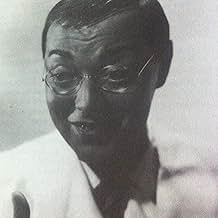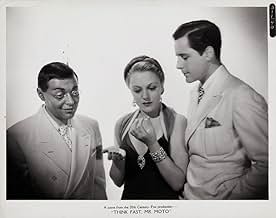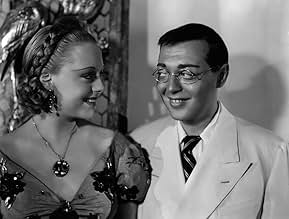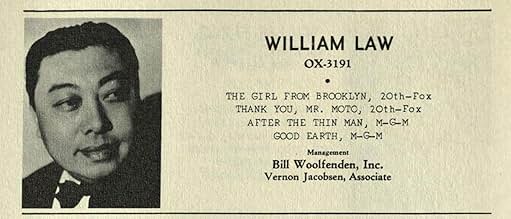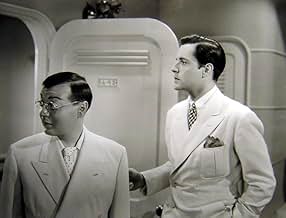NOTE IMDb
6,7/10
1,3 k
MA NOTE
Ajouter une intrigue dans votre langueOn a freighter going from San Francisco to Shanghai Mr. Moto solves mysteries caused by a gang of smugglers.On a freighter going from San Francisco to Shanghai Mr. Moto solves mysteries caused by a gang of smugglers.On a freighter going from San Francisco to Shanghai Mr. Moto solves mysteries caused by a gang of smugglers.
- Réalisation
- Scénario
- Casting principal
Sig Ruman
- Nicolas Marloff
- (as Sig Rumann)
Frederik Vogeding
- Curio Dealer
- (as Fredrik Vogeding)
Philip Ahn
- Switchboard Operator
- (non crédité)
Richard Alexander
- Ivan - Doorman
- (non crédité)
Lloyd Allen
- Nightclub Trombonist
- (non crédité)
William A. Boardway
- Ship Passenger
- (non crédité)
Dudley Brooks
- Nightclub Pianist
- (non crédité)
George 'Red' Callender
- Nightclub Bassist
- (non crédité)
Marcello Estorres
- Ship Passenger
- (non crédité)
Avis à la une
This was the first by 20th Century-Fox in a series of several films which tried to emulate the success of their own popular Charlie Chan series. THINK FAST, MR. MOTO introduced us to Peter Lorre's portrayal of a seemingly meek and mild mannered Asian man in glasses who secretly becomes a very clever and rough and tumble detective, excelling in martial arts and physical combat. The story involves jewel smuggling aboard a cruise ship, and while it comes off a tad clumsy the film remains brisk and enjoyable mainly because of Lorre's characterization, but also through the use of some very good seasoned professional actors (in this case, Sig Ruman and J. Carrol Naish). **1/2 out of ****
The shame of the Japanese-American concentration camps has cast a shadow over the Mr. Moto series, giving it a sorry reputation as an artifact of Hollywood racism. The truth is that as far as European-in-yellowface portrayals of Asians went, Peter Lorre's Moto was far less racist and considerably more sympathetic than the clownish, epigram-spouting Charlie Chan. In fact, it's easy to forget Moto's Japaneseness altogether and just view him as yet another wondrous manifestation of the white-linen-suited, Austrian-accented Lorreness so prevalent between the wars in films like "Strange Cargo," "Island of Doomed Men," und so wieter. Audiences certainly took to the little fellow in this first entry in the series, which introduces Moto in all his enigmatic glory--the bemused, politely ironical man of action with his love of kittycats, preference for cow's milk over whiskey, and disdainful conviction that beautiful women only confuse a man. Though Lorre reportedly had no idea what the whole thing was supposed to mean and spent his time offstage disconsolately listening to his archenemy Hitler on the radio, the eight Moto films established him as one of Hollywood's most beloved personalities and gave millions of small men who wore glasses the hope that they, too, could be strong and adorable.
Ah, the Thirties. What could be more elegant and enjoyable than an ocean liner to the Orient, with two heartbreakingly beautiful people having a shipboard romance while criminal intrigue sort-of-kind-of goes on around them and they are watched over by a genial Japanese man who may or may not be a good guy? And that's really about all there is to the slapdash plot of the first movie in the Mr. Moto series. Yes, there's something about diamond smuggling and murder, but the main point of this story seems to be to introduce the world to the polite but dangerous gentleman from Japan.
And that is something that surprised me about this little movie (it clocks in at under 70 minutes) -- just how dangerous Mr. Moto is. Throughout the first hour he is presented as someone who's more interested in making an allegiance with the smugglers than stopping them. The movie begins with him in disguise looking into the San Francisco end of the smugglers, seeing -- but not reporting -- a murdered body and getting away so he can quietly head for Shanghai. He shows he's a black belt in jiu-jitsu by tossing a few disrespectful drunks around, including the son of the man who owns the ocean liner he's traveling on. And he kills a killer in such a way that no one can find the body...then calmly, albeit a bit sadly, continues his secretive journey. It's not until the last few minutes of the movie that his real purpose and superior intelligence is revealed. To have a Japanese man out-thinking all the sneaky Caucasian minds around him is really quite startling for 1937, considering the casual xenophobia of the time.
"Think Fast, Mr. Moto" may be an obvious attempt to capitalize on the hugely popular (and usually much better) "Charlie Chan" series of mysteries, but it works very well in its own right. Peter Lorre does a fine job (of course) pretending to be Japanese, but something that I've never understood is why Thomas Beck never got to be big in Hollywood. He has such a natural grace in front of the camera, and he's extremely good-looking. The same holds for Virginia Field, though she did have more of a career than he. The production values are above average for a "B" movie and the pace is relatively brisk. If they'd just done a better job with the script, it could have been on the same level as "Charlie Chan in Shanghai." But as it is, it's still surprisingly fun.
And that is something that surprised me about this little movie (it clocks in at under 70 minutes) -- just how dangerous Mr. Moto is. Throughout the first hour he is presented as someone who's more interested in making an allegiance with the smugglers than stopping them. The movie begins with him in disguise looking into the San Francisco end of the smugglers, seeing -- but not reporting -- a murdered body and getting away so he can quietly head for Shanghai. He shows he's a black belt in jiu-jitsu by tossing a few disrespectful drunks around, including the son of the man who owns the ocean liner he's traveling on. And he kills a killer in such a way that no one can find the body...then calmly, albeit a bit sadly, continues his secretive journey. It's not until the last few minutes of the movie that his real purpose and superior intelligence is revealed. To have a Japanese man out-thinking all the sneaky Caucasian minds around him is really quite startling for 1937, considering the casual xenophobia of the time.
"Think Fast, Mr. Moto" may be an obvious attempt to capitalize on the hugely popular (and usually much better) "Charlie Chan" series of mysteries, but it works very well in its own right. Peter Lorre does a fine job (of course) pretending to be Japanese, but something that I've never understood is why Thomas Beck never got to be big in Hollywood. He has such a natural grace in front of the camera, and he's extremely good-looking. The same holds for Virginia Field, though she did have more of a career than he. The production values are above average for a "B" movie and the pace is relatively brisk. If they'd just done a better job with the script, it could have been on the same level as "Charlie Chan in Shanghai." But as it is, it's still surprisingly fun.
The first of the Lorre Moto's is also the best, and from under the opening titles to the snappy ending you do have some fast thinking to do. The production values were high, the script intelligent and the acting ... fairly good, all adding up to a non-condescending film. Moto's effortless jujitsu was always a laugh, though.
On the other hand it is chock full of the usual racial, sexual and social stereotypes that bother lots of serious people nowadays. But for it not to be present would be like meat without fat: pretty tasteless and indigestible. All present-day Austrians might be outraged by Peter Lorre's casting as a Japanese, and a warning should be given before every screening. I should have been warned that the ship's English steward would be Battling Burrows' son (see "Broken Blossoms" 1919)!
Dapper Moto is going after an international gang of smugglers operating out of Shanghai, where he seems to be up against the whole population much the same as Chan was 2 years earlier. Sig Rumann plays an ugly customer but Thomas Beck and Virginia Field never looked more handsome and lovelier playing the romantic leads. I don't know how many Moto's and Chan's in total they appeared in, but I tend to look out for Beck in every one just in case!
TFMM fills just over an hour pleasantly, and I have no hesitation in recommending it to the 21st century.
On the other hand it is chock full of the usual racial, sexual and social stereotypes that bother lots of serious people nowadays. But for it not to be present would be like meat without fat: pretty tasteless and indigestible. All present-day Austrians might be outraged by Peter Lorre's casting as a Japanese, and a warning should be given before every screening. I should have been warned that the ship's English steward would be Battling Burrows' son (see "Broken Blossoms" 1919)!
Dapper Moto is going after an international gang of smugglers operating out of Shanghai, where he seems to be up against the whole population much the same as Chan was 2 years earlier. Sig Rumann plays an ugly customer but Thomas Beck and Virginia Field never looked more handsome and lovelier playing the romantic leads. I don't know how many Moto's and Chan's in total they appeared in, but I tend to look out for Beck in every one just in case!
TFMM fills just over an hour pleasantly, and I have no hesitation in recommending it to the 21st century.
WITH THE SUCCESS and high popularity of the CHARLIE CHAN Series of movies, the logical next step was for some one to bring us another outstanding sleuth of Oriental extraction. There would be inevitable comparisons and "copycat" accusations. Certainly there is some similarity and there are some definite signs of, if not stealing, at least borrowing from the established CHAN franchise.
BUT THAT IS where the similarities end. For Moto is much more of a solitary operator; even though he does employ some operatives in this, the first movie in the series. Also, Moto's deducting appears to be much more introspective, silent and quietly disarming to friend and adversary alike.
THAT THE CHARACTER proved to be popular enough to have his own series of seven more entries into the series was largely due to the performance of the former Laszlo Lowenstein; now known to the world as Peter Lorre.
BUT THIS STAR'S tour de force, excellent production values, talented & ample supporting cast and memorable musical score wasn't enough to carry the series for more that its three years and eight movies. For the year was 1937 and the Imperial Japanese war machine was already conducting a war of conquest against China; after having conquered Manchuria in 1931.
THE ATROCITIES OF Pearl Harbor, Manila and Singapore, among others, would soon follow. The days of a Japanese super sleuth on our movie screens were numbered.
BUT THAT IS where the similarities end. For Moto is much more of a solitary operator; even though he does employ some operatives in this, the first movie in the series. Also, Moto's deducting appears to be much more introspective, silent and quietly disarming to friend and adversary alike.
THAT THE CHARACTER proved to be popular enough to have his own series of seven more entries into the series was largely due to the performance of the former Laszlo Lowenstein; now known to the world as Peter Lorre.
BUT THIS STAR'S tour de force, excellent production values, talented & ample supporting cast and memorable musical score wasn't enough to carry the series for more that its three years and eight movies. For the year was 1937 and the Imperial Japanese war machine was already conducting a war of conquest against China; after having conquered Manchuria in 1931.
THE ATROCITIES OF Pearl Harbor, Manila and Singapore, among others, would soon follow. The days of a Japanese super sleuth on our movie screens were numbered.
Le saviez-vous
- AnecdotesMr. Moto's hangover remedy: lemon juice, pinch of salt, 1 egg, 4 dashes orange bitters, 1 jigger Worcestershire sauce, 2 tsp sugar, absinthe, fill to top with gin. Stir. Drink.
- GaffesWhen Mr. Moto photographs Gloria in Honolulu, she is looking directly into the camera, but when he shows the photograph to the police chief in Shanghai she is looking away from the camera at Bob who is obscuring half the photograph even though he was standing beside Mr. Moto, not in front him, and thus should not be in the photograph at all.
- Citations
Kentaro Moto: Half the world spends its time laughing at the other half, and both are fools.
- ConnexionsFeatured in Cinema's Exiles: From Hitler to Hollywood (2009)
Meilleurs choix
Connectez-vous pour évaluer et suivre la liste de favoris afin de recevoir des recommandations personnalisées
- How long is Think Fast, Mr. Moto?Alimenté par Alexa
Détails
- Durée1 heure 10 minutes
- Couleur
- Rapport de forme
- 1.37 : 1
Contribuer à cette page
Suggérer une modification ou ajouter du contenu manquant

Lacune principale
By what name was L'énigmatique M. Moto (1937) officially released in India in English?
Répondre

